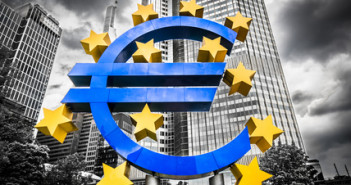Draghi giveth and Draghi drageth away.
The euro’s behavior in recent months is experiencing a change.
ECB pushes EUR down
The European Central Bank sent EUR/USD from the highs of nearly 1.40 in May 2014 to under 1.05 in March 2015. ECB president Mario Draghi first hinted of a negative rate in May 2014 and then acted in June, introducing rate cuts and a historic -0.10% deposit rate.
He then cut rates even deeper in September 2014, with a negative deposit rate of -0.20% further punishing banks parking money in Frankfurt. This pushed the common currency even lower.
The biggest move was the introduction of the QE program in January 2015, preceded by hints in December. The actual successful implementation of the bond buying scheme in March sent EUR/USD to its lows.
The ECB wasn’t alone: also the Fed’s ending of its own QE program in October 2014 (which was well telegraphed) and intentions to raise rates (which haven’t materialized just yet) have contributed.
ECB action backfires with crises
So, borrowing in euros is cheap, the ECB floodgates are open and keeping money in the zone is not yielding anything, to say the least. So, money is lent in euros and seeks riskier assets abroad, including emerging markets.
The euro is a funding currency since the spring of 2015.
And what happens to a funding currency in times of trouble? Money returns from the riskier assets abroad back to the origin, back to the safe haven. Yes, even if this is the port of Piraeus.
During the peak of the Greek crisis in late June and until early July, the euro often fell on news of progress around Greece and rose when uncertainty reached new highs. The clear example was the reaction to the July 13th aGreekment which saw the euro fall.
And the same happened with the Chinese crisis of late August, which has not reached an end. The euro, alongside the the long running Japanese yen, enjoyed the safe haven flows. They gained across the board, including against the US dollar.
The dollar did rise higher against other currencies but lost to the yen and the new safe haven of choice: the euro.
Enter Draghi
In the press conference on September 3rd, Draghi’s birthday, he mastered a change: while the ECB took only minor steps for now, he managed to push the value of the euro down with lower forecasts and readiness to do more.
But the shock waves extend beyond the 150 drop seen that day.
On Friday, the US published a mixed jobs report that gave a little bit for everyone, and especially a big dose of uncertainty about the Fed’s next move. Markets didn’t like this uncertainty and another wave of stock selling emerged. In currencies, the easy winner was the Japanese yen and the losers were the immediate suspects: commodity currencies.
And in this “risk off” move, we could already note a different behavior: the euro did not beat the US dollar as it did a week earlier with the Chinese crisis. The euro was on par with the dollar.
So, the yen remains the No. 1 safe haven, with the euro and the dollar trailing behind. Draghi managed to shift the sentiment towards the euro: not fully, but significantly.
And this begs the question: will the euro fall back into the “risk” basket and totally lose its safe haven appeal?
A lot depends on the next moves from the ECB which meets only in mid-October. But we might get an earlier answer already in mid September: the Fed decision on September 17th is critical for the value of EUR/USD, that’s clear, but it may also prove critical for the reaction function of the common currency.
More: 7 reasons why the Fed is likely to hike in September with big sweeteners
